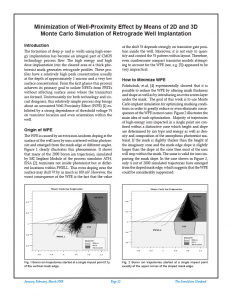Minimization of Well-Proximity Effect by Means of 2D and 3D Monte Carlo Simulation of Retrograde Well Implantation
Introduction
The formation of deep p- and n- wells using high-energy implantation has become an integral part of CMOS technology process flow. The high energy and high dose implantation into the cleared area of a thick photoresist mask generates retrograde profiles. These profiles have a relatively high peak concentration usually at the depth of approximately 1 micron and a very low surface concentration. From the first glance this process achieves its primary goal to isolate NFETs from PFETs without affecting surface areas where the transistors are formed. Unfortunately for both technology and circuit designers, this relatively simple process step brings about an unwanted Well Proximity Effect (WPE) [1] exhibited by a strong dependence of threshold voltage Vt on transistor location and even orientation within the well.



